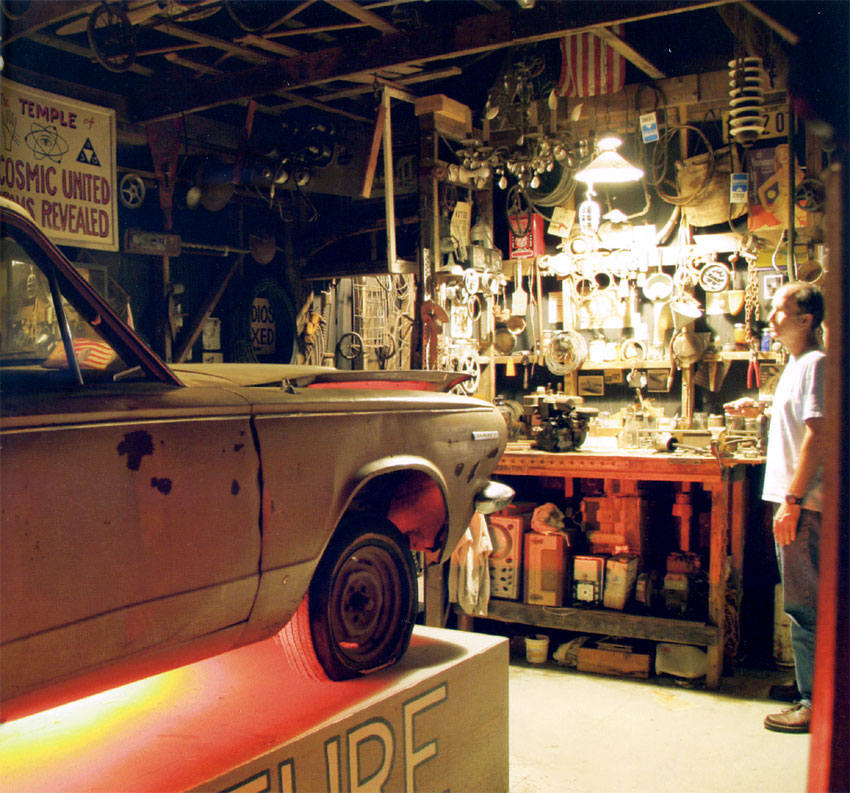I still think the revolution is to make the world safe for poetry, meandering, for the frail and vulnerable, the rare and obscure, the impractical and local and small.
Rebecca Solnit
It’s gone, so I’m gone.
If I were resigning from the Los Angeles County Museum of Art and not just canceling my membership, that’s the letter I’d send.
It is Michael C. McMillen’s installation “The Central Meridian”. For years LACMA patrons could walk through a not-so-low door in the wall and find themselves in what might be taken for a film-set recreation of a typical mid-sixties American garage, except that the car at its center is raised on a platform and lit from below, as if ready to take off, Repo Man-style, and amidst the tools and paint cans and bare bulbs and back issues of Popular Mechanics are signs of space-age primitivism; the cults and labs and cosmic temples of atomic mysteries that mark the Los Angeles of Aimee Semple MacPherson and L. Ron Hubbard; the Jet Propulsion Lab and Scientology; General Dynamics and Thomas Pynchon’s Yoyodyne.
Unfortunately, LACMA seems to have a way of contracting while it expands. They built a new wing for their contemporary art – a wing so grand in its patron’s mind that it calls itself a museum – but somehow no longer had room for “The Central Meridian” once they were done.
LACMA is the perfect museum for LA, in a way. It’s a sprawl; five decades’ worth of mismatched buildings, with Oklahoma eccentric Bruce Goff’s Japanese art pavilion the only distinguished one. (Not so much the revenge of the Okies as a belated gift.)
There is one other LACMA building worth the price of admission. The only problem is, it didn’t begin its life as a LACMA building, and in any case they probably won’t admit you. That’s the 1939 May Co. department store at the corner of Wilshire and Fairfax. It’s a classic piece of streamline moderne, with the corner facing the intersection rounded into a gold cylinder framed in black.
The store, with its tearoom for ladies who lunch and play cards, closed in the eighties and was bought by the museum in 1994. It houses museum staff. It also houses a lot of empty space. It also houses “The Central Meridian”.
It’s too perfect, really. The new LA gets a bad Renzo Piano building to house Eli Broad’s collection of Jeff Koons hackwork, and Michael McMillen’s brilliant piece of craftsmanship and imagination gets shunted off to this old LA landmark.
I’d like to think McMillen appreciates it. He was raised in Ocean Park, Santa Monica, with its crumbling amusement piers, veterans of three or four wars, aerospace workers, film technicians, and the resultant kipple scattered to the haunted streets.
“Kipple” is a word Philip K. Dick (surely a kindred [which is what the K stands for] spirit to McMillen) coined in Do Androids Dream of Electric Sheep?: “Kipple is useless objects, like junk mail or match folders after you use the last match or gum wrappers of yesterday's homeopape. When nobody's around, kipple reproduces itself. For instance, if you go to bed leaving any kipple around your apartment, when you wake up the next morning there's twice as much of it. It always gets more and more.”
And just as Dick took the stuff of pulp science fiction and turned it to literature, McMillen takes castoff technology – vacuum tubes and horseshoes and breadboxes – and turns it into art.
Now one of McMillen’s finest works has been cast out of LACMA to make room for junk art that skipped the usefulness stage of McMillen’s materials.
But maybe just as well. Maybe best that “The Central Meridian” exists in rumor and memory. And how perfect that it should end up in a shuttered and obsolete Los Angeles department store. I can’t imagine that the old May Co. is as secure as the other buildings at LACMA. Like subway tunnels with their disused stations and retired cars, this is the sort of place that ought to tempt urban spelunkers, the above-ground variety. “The Central Meridian” should be discovered in pieces, by nervy law-breakers and enemies of secrecy.

